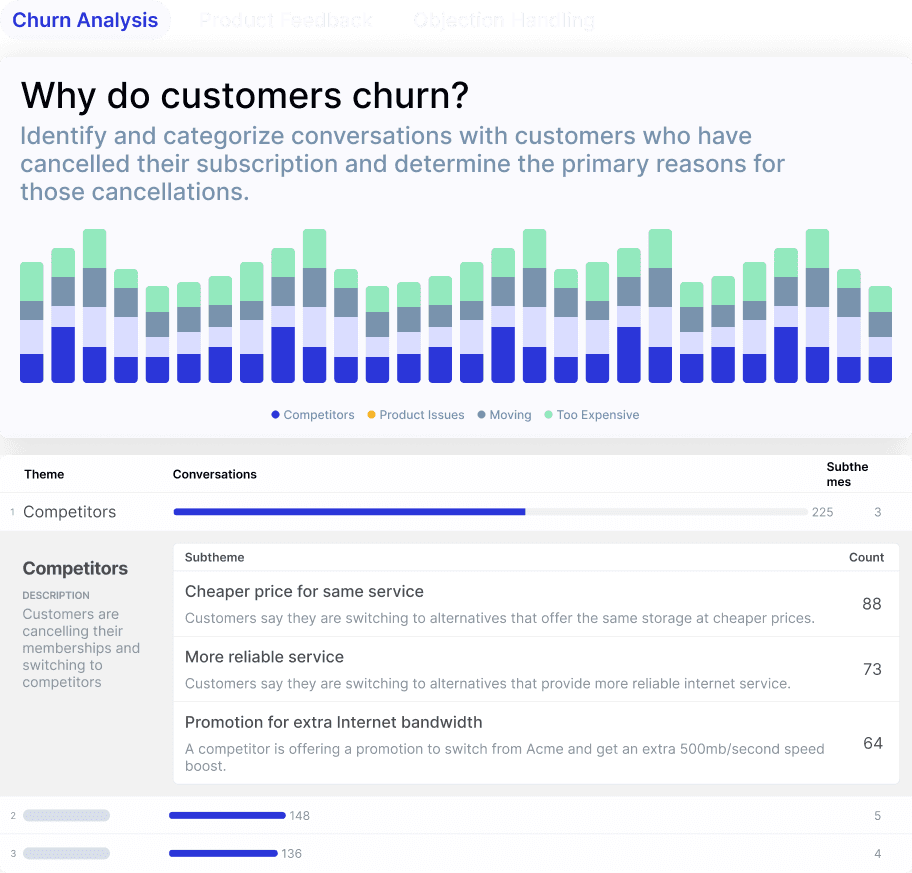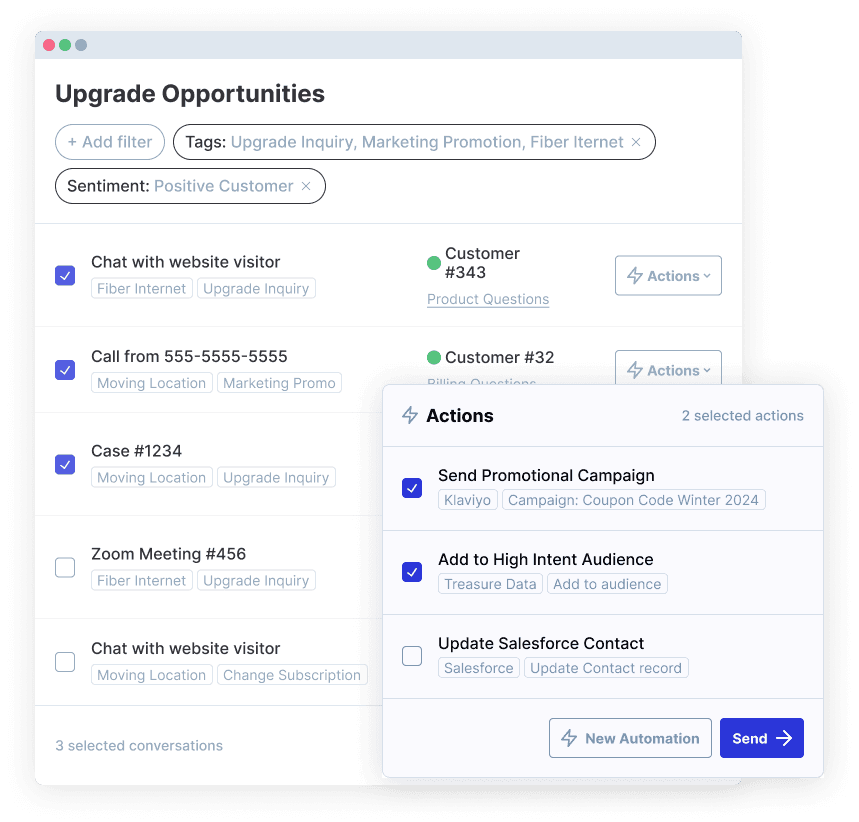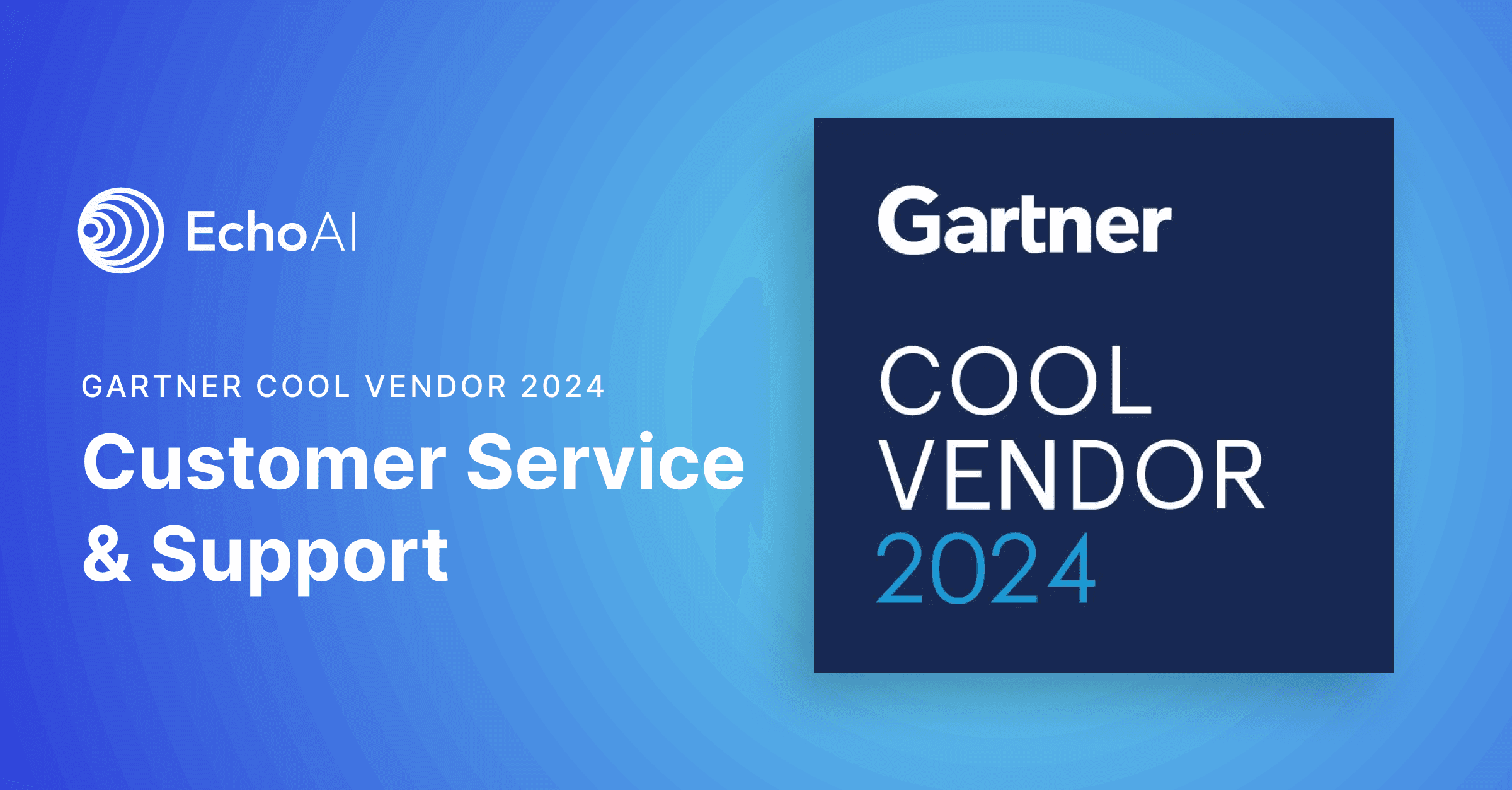Marketing
Jun 17, 2024
There are millions of insights swimming in customer conversation data. But these insights often remain siloed: customer service data goes to customer care and QA teams, social media data goes to marketing, and prospecting calls go to sales.
These data silos contribute significantly to poor data quality, which costs companies an average of $12.9 million annually according to Forrester.
As a function that is deeply tied to understanding the Voice of the Customer, marketing stands to gain immense value from chatbot interactions, calls, support tickets, and more to improve acquisition and lifecycle marketing efforts.
In this blog, we’ll explore how conversation insights can help bring in better quality leads, and the key ways marketing teams can apply generative insights to improve targeting, campaigns, and retention.
Table of Contents
Why Marketing Should Leverage Customer Conversation Data

In addition to pipeline goals, marketing leaders are tasked with hitting core KPIs such as customer acquisition cost (CAC), customer lifetime value (CLV), conversion rates, and more.
However, getting the necessary data to improve performance across these benchmarks isn’t easy. Data hygiene is a challenge, and the dependability of buyer intent data surfaced through traditional marketing platforms isn't enough to get a full picture.
Isn’t it valuable to also get learnings from customer interactions, rather than trying to predict lead behavior in the dark?
As Camille Manso, Partner at Silicon Valley shared on this MarTech Article outlining the importance of personalizing interactions with customer insights:
“[There is a need] for AI-driven consumer insight platforms that can help marketing, sales and customer service teams optimize and become more efficient.
What we’ve seen are the traditional mediums through which marketing campaigns are pushed out — emails, websites, social media. What we haven’t seen as much is how you take these personalized interactions that have emerged, particularly with chatbots, and use that data to optimize your marketing campaigns and messaging. That’s what Echo AI is able to do.”
By analyzing these data points from calls, chatbots, emails, and social feeds, marketing teams can tap into real-time data that reveals customer preferences, pain points, and behavior patterns, empowering them to fine-tune strategies and improve overall performance.
However, it doesn’t just stop at surfacing these insights. It’s also about making sure the learnings are used. Insights that aren’t applied to anything are like a dead end road. Only 29% of firms effectively use actionable insights derived from their data analytics, highlighting a real gap in leveraging analytics to drive business decisions and improve outcomes (Forrester).
Tying these learnings from customer conversations directly into workflows and processes is key.
That’s where automatic actions come in.
How Automatic Actions Engage, Convert, and Retain Customers
So, what are ‘automatic actions’?
An automatic action refers to the seamless and immediate application of generative insights to existing processes without manual intervention.
This involves using Generative Conversation Intelligence (CI) to analyze customer conversations in real-time. GenCI uses multiple large language models, or LLMs, to analyze millions of customer data points at once and extract robust, generative, or autonomously detected, insights on critical business risks and opportunities.

These generative insights are summarized by category— providing users with helpful overviews of intent, sentiment, and resolution scores—and organized into high-level themes and trends. With these topic summarizations, business leaders can quickly uncover the reasons behind call surges, cancellations, returns, and more.
From here, insights become trigger points that send alerts, actions or updates to other platforms to enhance and optimize targeting, campaigns, and churn prevention.
With GenCI, businesses can embed these automatic actions into their existing marketing workflows and ensure that insights are not only gathered, but also acted upon swiftly and efficiently. This enhances the customer experience, drives higher engagement, and increases conversion rates, all while reducing the need for manual data processing and decision-making.
Let’s go into some examples of what this might look like.
Optimizing Audience Segmentation
Knowing how to effectively segment audiences for advertising efforts determines not only how well ads perform, but also how well marketing can identify new business opportunities.
Generative insights can be used to improve how audiences are segmented, providing a way to optimize these cohorts at a much more data-driven level. GenCI can identify intent, or the key phrases, recurring topics, and sentiment indicators that reveal customer interests, concerns, and intentions.
With automatic actions, insights can be integrated into a Customer Data Platform (CDP) to update individual customer profiles. For instance, if a customer frequently asks about a particular product feature, their profile can be tagged to indicate a specific interest in that feature. Using these updated profiles, dynamic audience segments can be created, such as "interested in new products," "requires customer support," or "high purchase intent."

These segments can be flexible and automatically updated as new data comes in, reflecting the latest customer interactions. Automated marketing actions can then be set based on these segments. For example, customers tagged with "high purchase intent" can automatically receive targeted promotions, while those marked as "requires customer support" are prioritized for service. As an example, telecom contact center Centerfield leverages Echo AI’s genCI to update audiences on Facebook and Google ads, improving their ability to target better fit leads that have a higher likelihood of buying their cable and phone plans.
It provides a highly data-driven way to push ads and boosted posts to the right audiences, instead of wasted ad spend falling on disinterested customers. It also provides a mechanism to more strategically enroll audiences into promotional campaigns, which we’ll explore next.
Enrollment in Promotional Campaigns
The success of campaigns hinges on precise and effective targeting. Low performance can result from poor-quality data used to create and update segments. Consistent adjustments are necessary to remove unengaged contacts or incorrectly identified leads. Otherwise, campaign performance suffers as a result of insufficient information to dynamically update segmentation and targeting.
This is why using intent data surfaced from customer conversations is so powerful – it gives marketing a larger volume of inputs to analyze, and a broader context behind customer behaviors, motivations, and preferences.
In addition to creating and updating segments, GenCI can be used to improve messaging, personalization, and enrollment of contacts in offers, incentives, and campaigns.

For example, generative insights from customer conversations might reveal a strong interest in a certain type of product or service. In response, the marketing team crafts campaign messages to their audiences that highlight how these specific products or services are yielding results today, using success stories and testimonials to build credibility and motivate enrollment.
As such, businesses can create more effective and personalized marketing strategies that resonate with customers and drive better results. This approach ensures that promotional efforts are focused on the right audience, leading to higher engagement and improved customer satisfaction.
Intent data to improve conversions is just one aspect of a comprehensive marketing strategy powered by customer conversations. Equally important is the role of AI and machine learning in mitigating customer churn, enabling organizations to respond proactively to potential risks.
Mitigating Churn Risk
Preventing customer churn is an organization-wide priority that often involves marketing’s help in identifying opportunities for engaging customers at the right time, and with the right message, to retain customers who have one foot out the door. This starts with having the ability to detect these churn signals and then reflect the risks and opportunities these signals present.
So how might this be done?
First, sentiment and intent data from support calls can be used to trigger automatic actions that update a negative experience cohort in a CDP, dynamically updating it based on ongoing interactions. From here, the cohort can be automatically filtered to be excluded from recent advertisements, and at the same time, be targeted with personalized outreach that may include an apology message or unique incentive to regain trust.

Second, if several instances of negative interactions are detected, a customer can be identified as a potential churn risk. Automatic actions update their profile in the CDP, adding a new property or flag to the customer's data profile. This flag categorizes and segments customers based on their likelihood to churn, and can then be automatically added to a retention cohort within the CDP, which is a specific group of at-risk customers who can be targeted with retention strategies.
These actions might include sending targeted emails with discounted rates on services, enrollment in outbound call efforts, or offering loyalty rewards designed to re-engage and retain these customers.
In Conclusion
Generative insights powered by large language models hold immense potential for transforming marketing strategies by turning raw conversation data into actionable insights.
Automatic actions enable timely and personalized marketing efforts, enhancing customer engagement, conversion, and retention. Leveraging these insights across various channels—from support calls to social media—ensures a holistic approach to getting new customers and retaining existing ones.
Generative insights transform raw data into actions that can actually be tied to specific, targeted activities like timely campaign enrollment or narrow targeting. By integrating these insights across all customer channels, marketing teams can build a more informed strategy that ensures customer acquisition efforts are built on relevant and unique data from your customer interactions, which is the most valuable data you have.
This holistic approach not only breaks down data silos but also empowers marketing teams to confidently enhance targeting and promotional efforts, driving satisfaction and loyalty to new heights.




